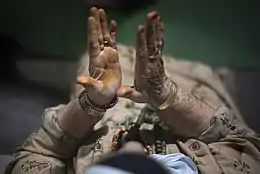Clapping
A clap is the percussive sound made by striking together two flat surfaces, as in the body parts of humans or animals. Humans clap with the palms of their hands, often quickly and repeatedly to express appreciation or approval (see applause), but also in rhythm as a form of body percussion to match the sounds in music, dance, chants, hand games, and clapping games.

Some people slap the back of one hand into the palm of the other hand to signify urgency or enthusiasm. This act may be considered uncouth by others.
Clapping is used in many forms of music. In American music, clapping is popular in gospel, doo-wop and early pop. In flamenco and sevillanas, two Spanish musical genres, clapping is called palmas and often sets the rhythm and is an integral part of the songs. A sampled or synthesized clap is also a staple of electronic and pop music.
Musical works that include clapping
Classical works performed entirely by clapping
- Steve Reich, Clapping Music (1972)
- Robert Paterson, Voices (1988)[1]
- Pascal Zavaro, Kino-Klap (2008)
Classical works which include clapping
- Carlos Surinach, Ritmo Jondo (1953)
- David Chesky, Flute Concerto et Violin Concerto
The clapping patterns known as keplok are important in Javanese gamelan. A type of synthesized clap is popular in many rap and hip hop songs as well. This is derived from and mimics the technique used in older popular music (e.g. disco and funk of the 1970s), in which multiple instances of real handclaps were recorded or a single recording was made of a group of performers clapping in unison. This was usually done for the purpose of reinforcing the snare drum beat on the 2nd and 4th beats of the bar (offbeat). Modern R&B, hip hop, and rap often omit the snare drum, making the claps a more obvious and central feature of the beat.
Acoustics and medical applications
Clapping is useful in (medical) opening up blocked blood circulation. Clapping can be used in acoustics to check the reverberation time of a room. This is determined by measuring the clap's decay time.[2]
Pedagogical applications
- See: Counting (music).
Clapping is often used to help people recognize the rhythm in sounds. It can be used to help musicians count out rhythms.
It is also used to teach phonological awareness to students learning the ways words are constructed. They often clap out syllables to learn to break words into their component sounds.[3]
Sports and other pursuits
.jpg.webp)
During UEFA Euro 2016, Iceland's fans became widely known for their 'volcano clap' (or 'Viking clap') with a 'huh' chant, though it originated with fans of Scottish club Motherwell F.C.[4] Canberra Raiders fans subsequently adopted the 'Viking clap'.[5][6][7][8] Similarly, fans of the Minnesota Vikings have also adopted the 'Viking clap' to show support for the team, chanting 'skol' rather than the original 'huh' chant.
The term "clap hands" or "clap hands Charlie" is also used in aviation to mean an aircraft collision or wing-to-wing contact, the phrase being derived from the refrain in the song "Clap Hands! Here Comes Charley!"[9]
In the mid 2010s, a practice of clapping as a way to emphasize talking points emerged among African American women, especially when clapping out individual syllables in words. This was pointed out in popular media by the comedian Robin Thede on The Nightly Show with Larry Wilmore.[10] It has since become more widely applied both online, often using the "hand clap" emoji, and in person.[11][12]
See also
Notes
- Voices Archived 2008-05-16 at the Wayback Machine, RobPaterson.com.
- Papadakis, Nikolaos M.; Stavroulakis, Georgios E. (2020). "Handclap for Acoustic Measurements: Optimal Application and Limitations". Acoustics. 2 (2): 224–245. doi:10.3390/acoustics2020015.
- Brown, Carmen Sherry. "Language and Literacy Development in the Early Years: Foundational Skills that Support Emergent Readers" (PDF). Language and Literacy Spectrum. 24 (Spring 2014): 35–49. Retrieved 17 February 2020.
- "WATCH: Are Motherwell the inspiration behind Iceland's 'volcano clap'?". Sky Sports. 29 June 2016. Retrieved 8 April 2018.
- Dutton, Chris (4 September 2016). "NRL what we learnt: The Viking Clap to return for Raiders finals after record-setting win". The Canberra Times. Retrieved 8 April 2018.
- Helmers, Caden (21 August 2016). "NRL talking points: Raiders fans got nuts for 'Viking Clap' and the Josh Hodgson effect". The Canberra Times. Retrieved 8 April 2018.
- "NRL 2016 video: Canberra Raiders' fans do Viking clap before win over Parramatta Eels". FOX Sports. 21 August 2016. Retrieved 8 April 2018.
- Helmers, Caden (24 August 2016). "NRL: Canberra Raiders Luke Bateman and Sia Soliola want the Viking Clap to stay". The Sydney Morning Herald. Retrieved 8 April 2018.
- Partridge, Eric (2006). A Dictionary of Slang and Unconventional English. Routledge. p. 222. ISBN 978-0415291897.
- "The Nightly Show - Women's History Month Report: Black Lady Sign Language". Youtube. Comedy Central. Mar 17, 2016. Archived from the original on 2021-12-22. Retrieved 17 February 2020.
- Waldman, Katy (April 6, 2016). "Stop 👏 Emphasizing 👏 Your 👏 Point 👏 by 👏 Putting 👏 Clap 👏 Emojis 👏 After 👏 Every 👏 Word". Slate. Retrieved 17 February 2020.
- LaBouvier, Chaédria (16 May 2017). "The Clap and the Clap Back: How Twitter Erased Black Culture From an Emoji". Vice. Retrieved 17 February 2020.
References
- Brown, T. Pierce (2002). "Is Clapping Hands in Worship Appropriate?", Gospel Gazette.